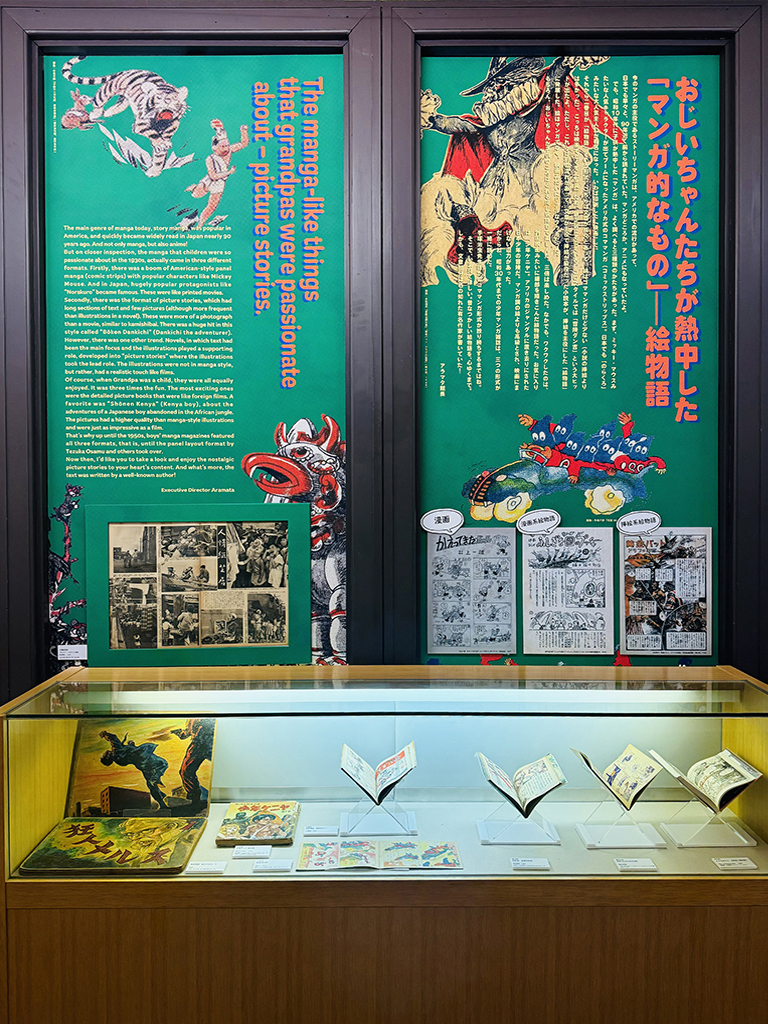
The 12th Treasure TroveMANGA-ful 2024 “Children's manga in the early postwar period”
The period when people read manga to satisfy cravings and feel energized and courageous!
2023/8/12(sat) ~2025/10/07(tue)
Venue
2F In front of executive director's office
Closures
Every Wednesday
Click here for details on the opening calendar
Online Ticket
*Same-day tickets can be purchased at the ticket vending machine at the entrance on the day of the
*You can purchase the admission ticket at the ticket vending machine when you enter the museum on the day you visit, or you can purchase it online in advance.
Content
The Kyoto International Manga Museum has an ongoing mini exhibition series called “Treasure Trove MANGA-ful”, curated by the museum’s Executive Director Aramata Hiroshi, with the aim of “tracing forgotten ancestors of manga to search the roots of contemporary manga”. The “MANGA-ful treasures”, as coined by Executive Director Aramata, include manga that are “as good as buried in the trash unless someone finds them”, and their value is that junk is intrinsically fun.
From the greetings of the exhibition by Director Aramata
Hello, I'm Director Aramata, who has been reading manga for a verrry long time. For this Treasure Trove MANGA-ful exhibition, we have found some rare items!
They are children's manga from the 1950s, when Japan was still a burnt-out land. But no, when I say manga, I don't mean so called “Cool Japan” anime-style manga of the present day. These are like illustrated picture books. The main feature is a “picture” on each page which represents a long section of text! Children at the time were obsessed with these picture books.
The reason is that, at that time children enjoyed street kamishibai (picture story shows) every day, which was like “street television” except it was a very analogue medium. So, editors from the children's magazines that were revived after the war thought “yes, let's make a comeback modelled on kamishibai!” and started publishing books about the kamishibai heroes that children adored at the time. The most popular was called “Ōgon bat” (Golden bat) who was essentially the Japanese version of “Batman”, and it was published in a magazine Boken katsugeki bunko (Collection of adventure action). At this point it's hard to know if it was really a book or a magazine. Later on, it was renamed Shonen gaho (Boy's pictorial) and it's easy to see why they chose the title “gaho” (pictorial). Indeed, the artists in charge of the illustrations were kamishibai artists. A kamishibai picture is like a single illustration in a novel, with the dialogue written on the back, so naturally you can get an impression like gekiga (dramatic manga aimed at adults) from it. Mizuki Shigeru, the creator of the manga “GeGeGe no Kitar?”, was also a kamishibai artist.
Of course, manga with speech bubbles and panel layouts were also popular, and manga was not just in magazines, it was also published widely as cheap books called akahon. Tezuka Osamu in particular was charismatic and popular, so, many artists used his manga as a model of inspiration. You can clearly see it from this exhibition. Akahon manga were produced massively at that time, and some even give the impression that they might have been created by someone without a lot of drawing experience.
At first, pictures and text were used to make the stories, but then the text disappeared over time and were replaced by speech bubbles and panel layouts until manga in its entirely pictorial form became the mainstream.
Another characteristic of children's magazines of that era was that the stories, pictures, and titles were all energetic, exaggerated, and exciting. They especially loved using the word b?ken (adventure).
Boken katsugeki bunko (Collection of adventure action) was followed by Boken roman (Adventure romance), Boken o (Adventure king), and even Boken shonen (Adventure boy) with Ikeda Daisaku as its editor-in-chief!
Please enjoy this honest old-fashioned manga from the Showa era. These children's magazines from about 80 years ago gave us dreams and hope when there was not much to eat. They are enough to fill an empty stomach!
Kyoto International Manga Museum / “Treasure Trove MANGA-ful” Executive Director, Aramata Hiroshi



Organizers: Kyoto International Manga Museum / Kyoto Seika University International Manga Research Center
* Please note that the schedule and contents are subject to change.